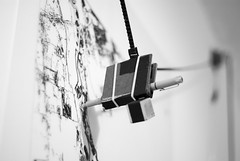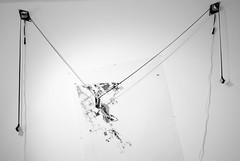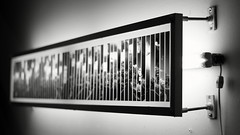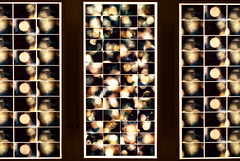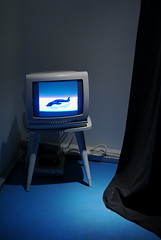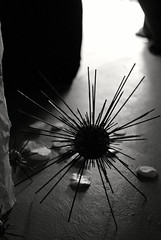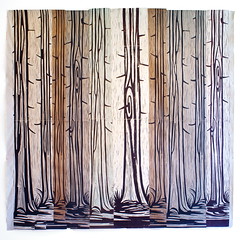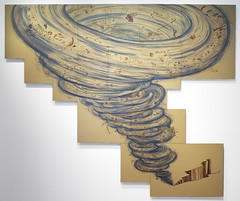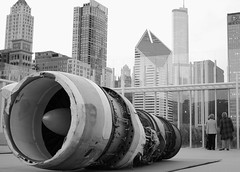
Thirty-one years earlier, May 25, 1979, one jet engine separated from the wing of American Airlines Flight 191 on take-off from O'Hare International Airport. 271 people (258 passengers and 13 crew) were killed as that McDonnell Douglas DC-10 exploded into the ground. After the crash, in 1981, Chicago punk band Effigies released the Flight 191-inspired track "Bodybag" via Ruthless Records, committing what remains the deadliest single plane event in the United States to local music lore.
Boeing acquired McDonnell Douglas in 1997. Though blame for the 1979 disaster was attributed to maintenance and not engineering, McDonnell Douglas never fully recovered from the negative publicity which followed the event.
On May 10, 2001, having been offered multimillion-dollar incentives by Illinois politicians including former Governor and now federal inmate George Ryan, Boeing announced its intention to relocate from Seattle to Chicago, as opposed to Denver or Dallas. Several months later in the 2001 calendar year, on September 11, four Boeing aircraft (United Airlines' Flights 93 and 175 in addition to American Airlines' Flights 11 and 77) figured prominently in the most memorable act of terrorism on domestic soil.
The history, above, is truncated but necessary. Creative works which are said to depend--principally--upon choice and placement must be considered in relation to the time and place of their exhibition.
+ + +
Here and now, for the piece "Untitled (Alliance)" British artist Roger Hiorns (born 1975) has chosen two Pratt and Whitney TF33 P9 turbofans and, in company with the Art Institute of Chicago's Frances and Thomas Dittmer Chair and Curator of Contemporary Art, James Rondeau, had them placed atop the third floor (rooftop) Bluhm Family Terrace. Major funding for the exhibition was provided by Boeing.
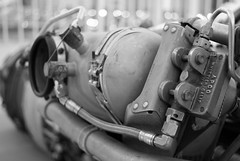
Note: The variable components (engines) of Hiorns' installation never crossed the threshold and entered the "white cube" space of the museum's galleries. That's important; that's problematic. The downtown architecture of Chicago forms a mighty backdrop against which all (unveiled) exhibitions on the Terrace are forced to act. Visually, Hiorns' composition amounts to little more than a juxtaposition of airplane parts and high-rise buildings. And for anyone with an understanding of current affairs and/or regional history that sight is likely to be upsetting. Did Hiorns (Rondeau) intend to cause such an upset, thereby provoking a reaction from the audience? Did Boeing, in its capacity as a corporate sponsor, knowingly fund and (at least potentially) strengthen the association between itself and such tragedy? Or, was Hiorns' piece imagined (and pitched) to include only the engines?
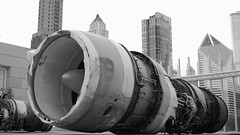
In a formal sense, in its present location, the experience of Hiorns' 2010 Chicago piece is framed by elements of functional design and not "artworks" per se. Nothing here was crafted by the artist; nothing here was crafted but for a "real" need. The two jet engines present as being identical: in shape they're frustums of attenuated ovoids, circular in cross-section, systemic complexity nearly organic in appearance. In contradistinction, the city's skyline takes the form of a greater sculptural work consisting of high-rise, largely rectilinear and Modern, buildings, whose carefully ordered facades of glass, stone and steel are intact.
Hiorns' attention to surface treatments has been notable, e.g., "Seizure" from 2008, wherein a London residence was filled with a chemical solution which precipitated a layer of blue crystal throughout the interior--later drained and made available for view. Here, in what seems to be a contrary maneuver, the two jet engines of "Untitled (Alliance)" have had their aluminum skins mostly flayed. Too, a wall-mounted plaque, and a press release, want the audience to know that, "Effexor, Citalopram, and Mannitol, three pharmaceuticals used to treat trauma and depression," have been put into the engines, and left in place. Yet within their opaque, metallic containers the medicines remain inaccessible to either hand or eye; one has to trust the plaque.
Forcing the (attentive) viewer to consider the relationship between the state of trust and the act of verification might well have been one of the artist's aims. Hiorns claims to have chosen engines from a plane which contributed to the U.S. military effort via intelligence gathering missions. But, again, that knowledge is not available to the general public (or press) but for consultation with the plaque or the release.
Why then not say that the real "artwork" is the text which accompanies the objects and not the objects themselves? "Untitled (Alliance)" is, after all, a conceptual piece. And it's not only through the collection of information that regimes sustain their power--but it's also by means of the careful dissemination of information that regimes sustain their power. Has Hiorns (Rondeau) wittingly or unwittingly played the role of the propagandist? How ought we (audience) to act in order to verify the story which has been told to us?
Roger Hiorns
May 1–September 19, 2010
Art Institute of Chicago
Modern Wing, Monroe Street entrance
Bluhm Family Terrace, Third Floor
http://www.artic.edu
Roger Hiorns,
http://en.wikipedia.org/wiki/Roger_Hiorns
Roger Hiorns and James Rondeau in conversation,
http://blog.artic.edu/blog/2010/06/16/roger-hiorns-in-conversation
First draft, May 10, 2010, in Newcity:
http://art.newcity.com/2010/05/10/review-roger-hiornsart-institute-of-chicago
Second draft, August 31, 2010, at this location.
- Paul Germanos
